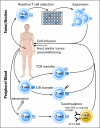Immunotherapy for ovarian cancer: what's next?
- PMID: 21079136
- PMCID: PMC3068064
- DOI: 10.1200/JCO.2009.27.2369
Immunotherapy for ovarian cancer: what's next?
Abstract
In the past decade, we have witnessed important gains in the treatment of ovarian cancer; however, additional advances are required to reduce mortality. With compelling evidence that ovarian cancers are immunogenic tumors, immunotherapy should be further pursued and optimized. The dramatic advances in laboratory and clinical procedures in cellular immunotherapy, along with the development of powerful immunomodulatory antibodies, create new opportunities in ovarian cancer therapeutics. Herein, we review current progress and future prospects in vaccine and adoptive T-cell therapy development as well as immunomodulatory therapy tools available for immediate clinical testing.
Conflict of interest statement
Authors' disclosures of potential conflicts of interest and author contributions are found at the end of this article.
Figures


References
-
- Bukowski RM, Ozols RF, Markman M. The management of recurrent ovarian cancer. Semin Oncol. 2007;34:S1–15. - PubMed
-
- Ozols RF. Systemic therapy for ovarian cancer: Current status and new treatments. Semin Oncol. 2006;33:S3–11. - PubMed
-
- Clarke B, Tinker AV, Lee C, et al. Intraepithelial T cells and prognosis in ovarian carcinoma: Novel associations with stage, tumor type and BRCA1 loss. Modern Pathology. 2008;22:393–402. - PubMed
Publication types
MeSH terms
Substances
Grants and funding
LinkOut - more resources
Full Text Sources
Other Literature Sources
Medical
Miscellaneous

